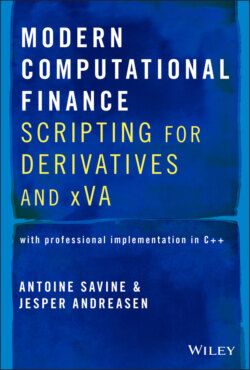Читать книгу Modern Computational Finance - Antoine Savine - Страница 16
NOTES
Оглавление1 1 Depending on scripting grammar, that barrier could also be written in functional form:STRIKE100BARRIER12001Jun2020append ( vFixings, spot())Start: 01Jun2020End: 01Jun2021append ( vFixings, spot())Freq: weekly01Jun2021opt pays (max( vFixings) < BARRIER) * max( 0, spot() ‐ STRIKE)We develop a classic, procedural scripting language in what follows, although readers can easily apply the logic and code of this book to design a functional scripting language like in the script above, or implement the grammar of their choice.
2 2 We develop a scripting language similar to a high‐level language like Python, not a programming language like C++. Classic constructs like variables, loops, and conditions are part of the language, as well as special keywords for the description of cash‐flows, such as spot(), which references simulated market prices. Of course, this is one particular choice and different rules are implemented with minor modifications, for example, a C/C++ inspired syntax or a functional grammar without conditionals or variables.
3 3 All transactions against a counterparty.
4 4 Stochastic volatility models are covered in many textbooks, including [21] [13], [3], or our lecture notes [26].
5 5 It is indeed relevant for calibration.
6 6 We can accommodate step‐wise MC in a trivial, if memory‐inefficient manner: store the paths generated step‐wise and deliver them path‐wise to the script evaluator.
7 7 The model also generates a value for the numeraire under which it performs the simulation, although that numeraire is a scalar value (per event date) that must be simulated and communicated in all circumstances.
8 8 Any condition can be evidently expressed under one of these forms; for example, is obviously the same as with . We built a pre‐processor to transform all conditions under these canonical forms.
